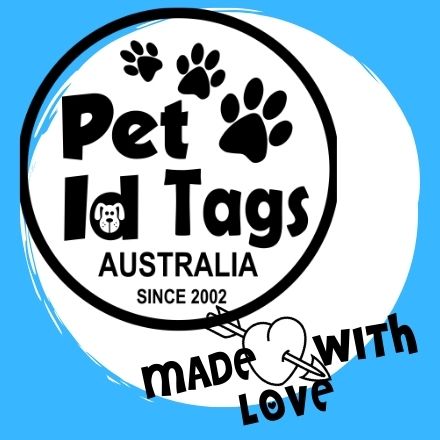Welcome to 'Dog Tags 101: Everything You Need to Know.' Whether you're a new dog owner or a seasoned pet parent, dog tags are essential for the safety and well-being of your furry friend. In this comprehensive guide, we'll dive into all the important aspects of dog tags, from their purpose to the different types available in the market.
Discover why dog tags are more than just stylish accessories for your pup. These small, engraved pieces hold crucial information, such as your dog's name, your contact details, and medical information, providing important identification if your furry friend ever gets lost. We'll also discuss the different materials and designs, so you can find the perfect dog tag that matches your pet's personality.
Our expert tips and insights will help you choose the most durable and easy-to-read dog tags, ensuring your dog's safety and your peace of mind. From traditional metal tags to trendy customized options, we've got you covered. So, join us on this journey to become a dog tag expert and keep your four-legged companion safe and sound at all times.
What are dog tags?
Dog tags are small, flat pieces of metal or other materials that are attached to a dog's collar. They typically contain important information about the dog and its owner, serving as a form of identification. These tags are designed to be easily visible and readable, even from a distance. They are an essential tool in ensuring the safety and well-being of your furry friend.
Dog tags have a long history, originally being used by the military to identify soldiers. Over time, their use extended to domestic dogs, providing a simple and effective way to identify lost or stray pets. Today, dog tags come in various shapes, sizes, and materials, allowing pet owners to choose the option that best suits their needs and preferences.
The importance of dog tags for pets
Dog tags play a crucial role in ensuring the safety of your pets. They provide a quick and easy way for anyone who finds your lost dog to contact you and reunite you with your beloved companion. Without proper identification, finding your lost pet can be a challenging and time-consuming process. Dog tags make this process much simpler and increase the chances of a successful reunion.
Additionally, dog tags can also provide vital medical information in case of emergencies. Engraving your dog's medical conditions or allergies on the tag can help veterinarians or first responders provide appropriate care when needed. This information can be life-saving, especially if your dog requires specific medications or has any health conditions that need immediate attention.
How to choose the right dog tag for your pet
Choosing the right dog tag for your pet is essential to ensure its effectiveness and durability. Here are some factors to consider when selecting a dog tag:
1. Material: The material of the dog tag plays a significant role in its durability and longevity. Metal tags, such as stainless steel or aluminum, are popular choices due to their resistance to rust and wear. Silicone tags are great for dogs who are bothered by the noise of metal tags, while plastic tags are lightweight and affordable.
2. Size and Shape: The size and shape of the dog tag depend on your pet's collar and personal preference. Make sure the tag is large enough to accommodate all the necessary information without being too bulky or heavy for your dog to wear comfortably. Consider the shape of the tag as well, ensuring it doesn't have any sharp edges that could potentially harm your pet.
3. Engraving Quality: The legibility of the engraving on the tag is crucial for its effectiveness. Look for tags that offer deep and clear engraving, making the information easily readable. Avoid tags with shallow or faint engraving, as they may become illegible over time due to wear and tear.
4. Attachment Method: Pay attention to the attachment method of the dog tag. Some tags come with split rings that can be easily attached to the collar, while others may have different mechanisms, such as hooks or clips. Choose a tag that securely attaches to the collar and won't easily come off during your dog's activities.
5. Reflective or Glow-in-the-Dark Tags: If you often walk your dog during low-light conditions, consider getting a reflective or glow-in-the-dark tag. These tags enhance visibility and make your dog more visible to motorists or pedestrians, reducing the risk of accidents.
Remember to include all the necessary information on the dog tag, such as your dog's name, your contact details, and any important medical information. Double-check the accuracy of the information before finalizing the engraving to avoid any potential issues.
Engraving options for dog tags
The engraving on a dog tag is what makes it unique and informative. When it comes to engraving options, there are a few things to keep in mind:
1. Font Size and Style: Choose a font size and style that is easily readable. Avoid using overly decorative or intricate fonts that may make the text difficult to decipher. Opt for clear and legible fonts that ensure the information on the tag can be quickly and easily understood.
2. Information to Include: Decide on the essential information you want to include on the tag. This typically includes your dog's name and your contact details, such as your phone number and address. You may also consider adding any relevant medical information, such as allergies or chronic conditions, to ensure your dog receives the appropriate care if needed.
3. Double-Sided Engraving: Some dog tags offer the option of double-sided engraving. This allows you to include more information without compromising the legibility. You can add additional contact details, a secondary phone number, or even a microchip ID number on the back of the tag.
4. Symbols and Icons: To enhance the visual appeal of the tag, you can consider adding symbols or icons that represent your dog's personality or your personal preferences. These can be simple shapes, paw prints, or even small images of your dog's favorite toy or breed.
Ensure that the engraving is deep enough to withstand daily wear and tear. Shallow engraving may fade over time, making the information on the tag illegible. Regularly check the engraving for any signs of fading or damage and replace the tag if necessary.
How to properly attach and use dog tags
Properly attaching and using dog tags is crucial to ensure their effectiveness. Here are some tips to keep in mind:
1. Secure Attachment: Make sure the dog tag is securely attached to your dog's collar. Use split rings, hooks, or clips provided with the tag to ensure a tight and secure fit. Regularly check the attachment to ensure it hasn't become loose or damaged.
2. Wear and Tear: Dog tags are subject to wear and tear, especially if your dog is active or likes to play rough. Regularly inspect the tag for any signs of damage, such as scratches or fading engraving. Replace the tag if necessary to ensure the information remains visible and readable.
3. Collar Fit: Ensure that your dog's collar fits properly and is comfortable to wear. A collar that is too tight or too loose can cause discomfort or even pose a safety hazard. The dog tag should be attached to the collar securely, without impeding your dog's movement or causing any irritation.
4. Regular Checks: Regularly check the information on the dog tag to ensure it is up to date and accurate. Update your contact details if necessary and verify that the engraving is still legible. It's also a good idea to periodically clean the tag to remove any dirt or debris that may accumulate over time.
Dog tag regulations and requirements
While dog tag regulations and requirements may vary depending on your location, there are some general guidelines to keep in mind:
1. Mandatory Identification: Many jurisdictions have laws that require dogs to wear identification tags when in public places. These tags typically include the owner's contact information and may also require a license number or other specific details. Familiarize yourself with the local regulations to ensure compliance.
2. Microchipping: In addition to dog tags, microchipping is becoming increasingly popular and may be a legal requirement in some areas. Microchips are small electronic devices implanted under the skin, containing a unique identification number that is registered to your contact details. They provide an additional layer of identification and can be scanned by veterinarians, shelters, or animal control agencies.
3. Vaccination Tags: Some jurisdictions may require dogs to wear tags indicating their up-to-date vaccination status. These tags typically display the dog's vaccination record and may need to be renewed annually or whenever vaccinations are updated.
4. Travel Requirements: If you plan to travel with your dog, whether domestically or internationally, there may be specific requirements regarding identification. Some countries may have strict regulations that require specific types of tags or documentation. Research the travel requirements well in advance to ensure a smooth and hassle-free journey.
Always stay informed about the regulations and requirements in your area to ensure compliance and avoid any potential fines or penalties.
Personalizing dog tags with additional information
While the primary purpose of dog tags is to provide identification and contact information, you can also personalize them with additional details that are important to you. Here are some ideas for personalizing your dog's tag:
1. Medical Information: In addition to basic contact details, you can include specific medical information on the tag. This can include allergies, chronic conditions, or any medications your dog may be taking. This information can be vital in case of emergencies or if your dog requires immediate medical attention.
2. Reward Offer: Adding a "Reward" mention on the tag can incentivize people to help find your lost dog. This can be an effective way to increase the chances of a successful reunion.
3. Personality Traits: If you want to add a touch of personality to your dog's tag, consider including a brief description of your dog's personality traits or preferences. This can be a fun and unique way to showcase your dog's individuality.
Remember to balance personalization with the legibility of the tag. Too much information or overly decorative elements can make the tag difficult to read, defeating its purpose.
Tips for maintaining and replacing dog tags
To ensure the longevity and effectiveness of your dog tags, follow these maintenance tips:
1. Regular Cleaning: Dog tags can accumulate dirt, debris, or even bacteria over time. Regularly clean the tag using mild soap and water to keep it hygienic and prevent any build-up that may affect the legibility of the engraving.
2. Inspect for Damage: Periodically inspect the tag for any signs of damage, such as scratches or fading engraving. Replace the tag if necessary to ensure the information remains visible and readable.
3. Update Information: Regularly review the information on the tag to ensure it is up to date. Update your contact details if necessary and add any relevant medical information. Accurate and current information increases the chances of a successful reunion if your dog ever gets lost.
4. Consider Spare Tags: Having spare tags on hand can be useful in case of emergencies or if the original tag becomes lost or damaged. Keep a spare set of tags with up-to-date information to ensure your dog always has proper identification.
Remember that dog tags are not indestructible and may need to be replaced over time. The frequency of replacement depends on various factors, such as the material of the tag, your dog's activity level, and the wear and tear it experiences. Regularly check the tag for any signs of damage and replace it as needed to maintain its effectiveness.
Conclusion
Dog tags are more than just stylish accessories for your four-legged companion. They serve as a crucial form of identification, ensuring the safety and well-being of your pet. By choosing the right dog tag and engraving it with accurate and legible information, you can increase the chances of a successful reunion if your dog ever gets lost. Stay informed about the regulations and requirements in your area and regularly maintain and replace your dog's tags to ensure their effectiveness. With the right dog tag, you can have peace of mind knowing that your furry friend is safe and protected at all times.



